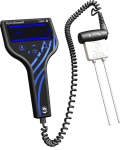This product is not available for new orders.

| Services Available | |
|---|---|
| Repair | Yes |
| Calibration | No |
| Free Support | Yes |
概览
CS625测量从 0% 到水饱和的体积含水量。与CS616类似,不过CS625专门为CR200(X)/CR300系列数据采集器设计的探头,探头输出0到3.3 V的高频方波,可以被我们的CR200(X)/CR300数据采集器所读取。
优势与特点
- 高精度和高精密性
- 快速响应时间
- 设计用于长期的无人值守的含水量监测
- 探头钢针可以从地表插入,或者以任何方位埋入地下
图像

技术说明
CS625含有连接到印刷电路板的2根30 cm长的不锈钢探针。电路板用环氧树脂封装,连接到电路板的4芯带屏蔽线缆给探头提供电源、激活测量以及监测输出信号。
CS625采用时域反射技术测量多孔介质(例如土壤)的体积含水量。类似TDR100的时域反射主机(测线器)对于CS625并不需要。CS625生成电磁脉冲,消逝行程时间和脉冲反射继而被测量,用于计算土壤体积含水量。
响应特征
沿CS625平行探针传输的信号被土壤溶液中的自由离子和土壤矿物成分的导电组分所消弱。在大多数应用中,该衰减并不足以影响CS625对土壤含水量变化的响应。CS625的响应曲线较好地被标准校准所描述。不过,在较大电导率的土壤、压实土、或较高粘土矿物含量的土壤中,应该特定土壤调整校准曲线。在CS625说明书提供了做这些校准调整的指导。
产品规格
| 操作温度范围 | 0° to 70°C |
| Probe-to-Probe Variability | ±0.5% VWC in dry soil, ±1.5% VWC in typical saturated soil |
| Precision | 0.1% VWC |
| Resolution | 0.1% VWC |
| Output | 0 to 3.3 V square wave (with frequency dependent on water content) |
| Current Drain | 65 mA @ 12 Vdc (when enabled) |
| Power Supply Voltage | 5 Vdc minimum; 18 Vdc maximum |
| Enable Voltage | 4 Vdc minimum; 18 Vdc maximum |
| Electromagnetic | CE compliant (Meets EN61326 requirements for protection against electrostatic discharge.) |
| Rod Spacing | 32 mm (1.3 in.) |
| Rod Diameter | 3.2 mm (0.13 in.) |
| Rod Length | 300 mm (11.8 in.) |
| Probe Head Dimensions | 85 x 63 x 18 mm (3.3 x 2.5 x 0.7 in.) |
| Cable Weight | 35 g per m (0.38 oz per ft) |
| Weight | 280 g (9.9 oz) without cable |
兼容性
Please note: The following shows notable compatibility information. It is not a comprehensive list of all compatible products.
数据采集器
| Product | Compatible | Note |
|---|---|---|
| CR200X (retired) | ||
| CR206X (retired) | ||
| CR211X (retired) | ||
| CR216X (retired) | ||
| CR295X (retired) | ||
| CR300 (retired) | ||
| CR3000 (retired) | ||
| CR310 | ||
| CR5000 (retired) | ||
| CR800 (retired) | ||
| CR850 (retired) |
Additional Compatibility Information
RF Considerations
The RF emissions are below FCC and EU limits as specified in EN61326 if the CS625 is enabled less than 0.6 ms, and measurements are made less frequently than once a second. External RF sources can also affect the CS625 operation. Consequently, the CS625 should be located away from significant sources of RF such as ac power lines and motors.
Installation Tool
The CS650G makes inserting soil-water sensors easier in dense or rocky soils. This tool can be hammered into the soil with force that might damage the sensor if the CS650G were not used. It makes pilot holes into which the rods of the sensors can then be inserted. It replaces both the 14383 and 14384.
Data Logger Considerations
Each CS625 requires a single-ended input channel. A control port is used to enable one or more probes.
Note: A maximum of four CS625 probes can be measured by one CR200(X) datalogger. Valid channel options are analog channels 1 through 4.
常见问题解答
CS625: 29
展开全部收起全部
-
Yes, as long as the data logger can detect a 0 to 3300 mV square wave over a frequency range of 29 to 67 kHz.
-
Running the cable through electrical conduit or PVC pipe will protect the cable from rodents. A trench 30 to 60 cm deep will protect it from most other human or animal activity. Some customers have found that extra cable can be coiled and left inside a box, such as an irrigation valve box or something similar. When using a box, seal any holes that are large enough for rodents to enter. When cables are exposed on the ground surface, some customers have found that wrapping the cables in the metal screening used for screen doors discourages animals from chewing on them.
-
The period value is corrected to the temperature at which the water content calibration was performed, and then the water content equation is applied to the corrected period. Temperature correction is soil specific because the effect that temperature has on the period value varies with soil texture and electrical conductivity. A temperature correction equation that was developed for a sandy loam soil with low bulk electrical conductivity is provided in the CS616 and CS625 instruction manual.
-
The CS616 and CS625 are water-content reflectometers with measurement electronics built into the probe head. The electronics generate a signal, which is sent directly to the data logger. The CS610-L, and other three-rod probes sold by Campbell Scientific, are TDR probes that have no electronic components and serve as wave guides for a time-domain reflectometer such as the TDR100.
-
Campbell Scientific does not recommend splicing sensor cables. Sensors may be ordered with custom cable lengths, and Campbell Scientific recommends purchasing the correct length for the application. If the sensor cable needs to be lengthened, a junction box (if practical) is a more favorable option than a splice.
Note: A splice will void the sensor warranty, but a junction box does not modify the sensor and therefore does not void the warranty.
-
Fine roots do not significantly affect the CS616/CS625 reading.
-
If the new site has soil with a different soil type, a soil-specific calibration may be needed. For soil that is sandy or sandy loam with low bulk electrical conductivity, the calibration equation in the CS616 and CS625 instruction manual works well.
-
Some customers have tried to use the CS616 or CS625 to measure the moisture content within a tree, but the calibration proved to be problematic. Campbell Scientific cannot provide any specific guidance for this application.
-
Yes. The PeriodAvg() CRBasic instruction may be used to measure the CS625 on a CR1000, CR800-series, or CR3000 datalogger. To make this work, it is important that the Threshold parameter be set to 1650 mV as shown in the following example:
PortSet (1 ,1 ) ‘Enable CS625 by setting C1 high (orange wire to C1)
PeriodAvg (PA_uS,1,mV250,1,1650,0,100,10,1.0,0) ‘Read Period on SE1 (green wire to SE1)
PortSet (1 ,0) ‘Disable CS625 by setting C1 low
-
Yes. For program examples and guidance on using a multiplexer with one of these reflectometers, see the CS616 and CS625 instruction manual.



